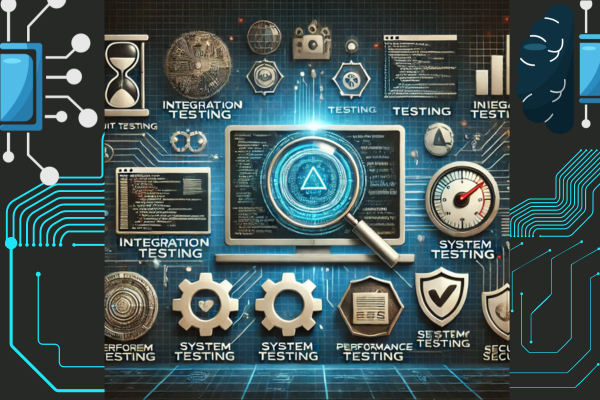In the rapidly advancing world of technology, software plays an important role in almost every aspect of our lives. From banking to healthcare to entertainment & education, we depend heavily on software applications. But what happens when these applications fail? An error in a banking app can lead to financial losses, while a bug in healthcare software can threaten patient safety. This is where software testing comes in. It is a process that ensures that the software works as intended, is reliable and meets the user’s expectations. In this blog, we will explore the requirements of software testing, different types of testing and the methods followed in the testing process.

Table of Contents
Why do we need software testing?
Imagine buying a car that hasn’t been tested for safety. Would you feel comfortable driving it? probably not. The same goes for software. Testing is necessary for several reasons:
1. Quality Assurance
Software testing guarantees that the final product satisfies quality requirements. It checks whether the software is user-friendly, functions properly, and meets the requirements set by the stakeholders.
2. Identifying and fixing bugs
Errors and defects will always occur when developing software, regardless of how experienced a developer is. Early defect detection through software testing facilitates easier and less expensive fault fixes.
3. Enhancing Security
One of the main issues in the digital age we live in today is security. Software testing finds security holes in the program and makes sure it is protected against outside threats like hacking and data leaks.
4. User Satisfaction
Any software’s primary aim is to satisfy the requirements of the user. Testing ensures that the program offers a positive user experience, which is necessary for maintaining and satisfying customers.
5. Follow the rules
Software needs to follow tight guidelines and standards set by numerous businesses. Testing helps ensure that software meets these legal and industry standards.
Types of software testing
Software testing is a wide field with many different testing techniques, each with a distinct function, each serving a specific purpose. Let’s look at the most common types:
1. Manual Testing
Manual testing is a process in which testers manually execute test cases without using any automation tools. This approach involves a tester playing the role of an end-user and using the application’s various features to ensure correct behaviour. The primary objective of manual testing is to identify bugs, issues, or defects in the software application.
2. Automation Software Testing
Automation testing uses software tools to automatically execute test cases. This is especially beneficial for repetitive tasks, regression testing, and large projects where manual testing would be too time-consuming. Automation increases efficiency and ensures consistent test execution.
3. Functional Software Testing
Functional testing focuses on verifying that the software performs its intended functions correctly. It checks the features and operations of the software against the specified requirements. For example, in a banking app, functional testing will test whether users can successfully transfer money, pay bills, or view their transaction history.
4. Non-Functional Software Testing
Non-functional testing evaluates aspects of software that are not directly related to specific tasks but are still important to its performance. This includes testing for performance, scalability, security and usability. For example, how quickly does the software respond to heavy traffic? Is it secure from unauthorized access?
5. Unit Testing
Unit testing involves testing individual components or units of software in isolation. Developers usually perform this test during the coding phase to ensure that each unit works properly before integrating with the others.
6. Exploratory Testing
Exploratory testing is an informal, unstructured approach where testers explore software without predefined test cases. It depends on the tester’s creativity, experience and intuition to find the fault.
7. Continuous Testing
Continuous testing is a key practice in DevOps, where testing is integrated into the CI/CD pipeline. Automated tests are continuously run to provide immediate feedback on code changes, ensuring fast and reliable software delivery.
Methods Followed in Software Testing
Different software testing methodologies have been developed to cater to the needs of various projects. The choice of method often depends on factors such as project size, complexity, and the development approach. The key methods include:
- Waterfall Methodology
- The Waterfall model follows a linear and sequential approach, where each phase of development, including testing, must be completed before moving on to the next. Testing occurs after the development phase, making it challenging to address issues discovered late in the process.
- V-Model
- The V-Model, also known as the Verification and Validation model, is an extension of the Waterfall methodology. In this model, testing activities are planned parallel to corresponding development activities. For instance, system testing is planned during the system design phase, ensuring that testing is aligned with the development process.
- Agile Methodology
- Agile methodologies promote iterative and incremental development, where testing is an integral part of every sprint. This approach emphasizes collaboration between developers, testers, and stakeholders, enabling continuous feedback and rapid delivery of high-quality software. Agile testing often includes practices like Test-Driven Development (TDD) and Behavior-Driven Development (BDD).
- DevOps and Continuous Testing
- DevOps is a culture and practice that combines development and operations to shorten the SDLC and deliver high-quality software continuously. Continuous testing is a critical aspect of DevOps, where automated tests are executed as part of the continuous integration/continuous delivery (CI/CD) pipeline. This approach ensures that defects are identified and addressed early in the development process, reducing the risk of failures in production.
- Shift-Left Testing
- The Shift-Left approach involves moving testing activities earlier in the development process, with the goal of identifying and addressing defects as early as possible. This method encourages collaboration between developers and testers from the initial stages of a project, reducing the cost and time associated with fixing defects later in the cycle.
- Behavior-Driven Development (BDD)
- BDD is an extension of TDD that focuses on the behavior of the software from the user’s perspective. It involves writing test cases in a natural language format, making it easier for non-technical stakeholders to understand and contribute to the testing process. BDD promotes collaboration between developers, testers, and business analysts, ensuring that the software meets user expectations.
- Test Automation Frameworks
- Test automation frameworks provide a structured approach to automating test cases, reducing manual effort and increasing test coverage. Common frameworks include Selenium for web applications, Appium for mobile applications, and JUnit for unit testing in Java. These frameworks support various testing methodologies and integrate seamlessly with CI/CD pipelines.
conclusion:
Software testing is an essential part of the software development process. It ensures that the software is reliable, and secure and meets the needs of the user. With a variety of test types and methods available, testing can be tailored to the specific requirements of a project. Whether it’s a simple app or a complex enterprise system, thorough testing ensures that the end product is of high quality, ultimately leading to satisfied users and successful software.
If you want to know about How Generative AI is Revolutionizing Content Creation in 2024 here we go!

